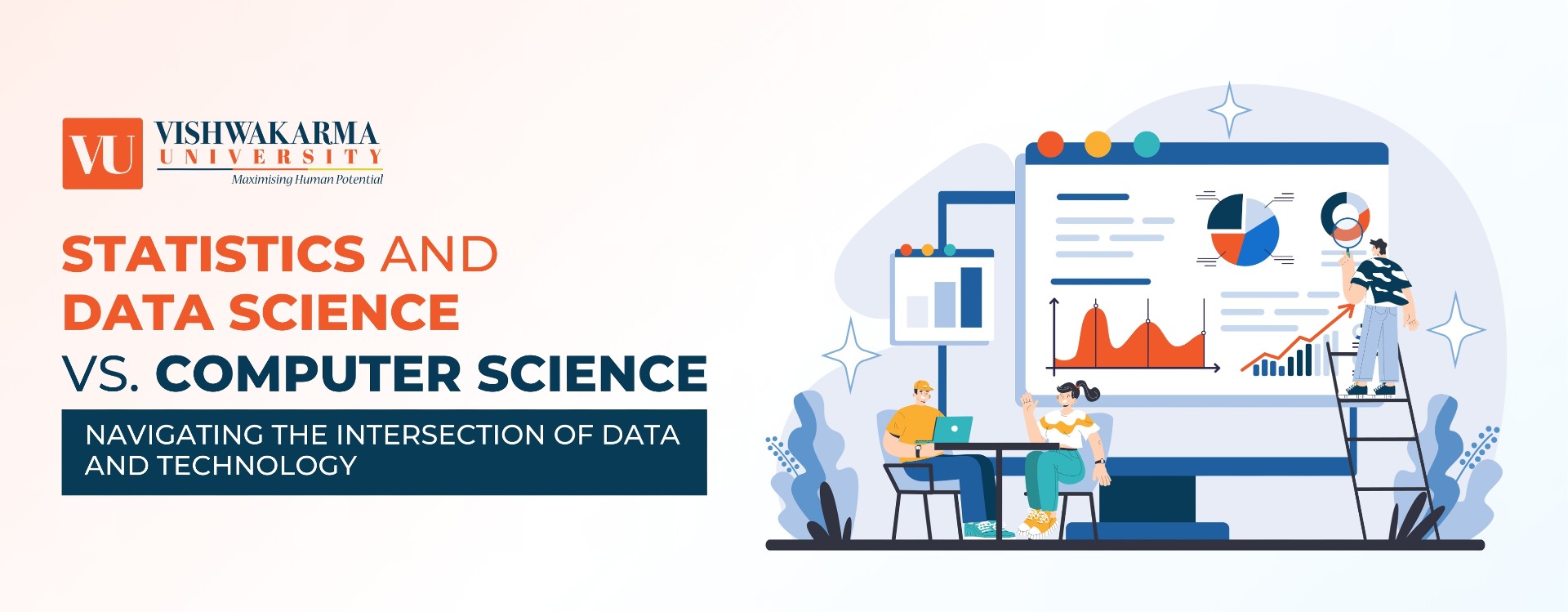Understanding Statistics and Data Science
Statistics and Data Science is a multidisciplinary field that combines statistical methods with computational techniques to analyze and interpret complex data. A Statistics and Data Science course equips students with skills in statistical modeling, machine learning, data visualization, and data mining. Graduates of a BSc Statistics and Data Science program are well-prepared to tackle real-world data challenges across various industries.
The scope in Statistics and Data Science is vast, encompassing roles such as data analysts, data scientists, statisticians, and machine learning engineers. These professionals use their expertise to extract actionable insights from large datasets, driving decision-making processes in business, healthcare, finance, and more. The growing importance of data in decision-making ensures a steady demand for Statistics and Data Science jobs, making it a promising career path.
Exploring Computer Science
Computer Science focuses on the theoretical foundations of computing, software development, and algorithm design. A BSc Computer Science program provides students with a deep understanding of programming languages, software engineering, systems architecture, and artificial intelligence. The scope of Computer Science is extensive, with applications in nearly every sector of the economy.
Graduates of Computer Science programs can expect diverse computer science job opportunities, ranging from software developers and systems analysts to cybersecurity experts and artificial intelligence specialists. The scope of Computer Science engineering is particularly broad, with professionals often involved in designing and developing innovative technologies that transform industries. Additionally, the highest paying jobs in Computer Science are often found in fields such as AI, cybersecurity, and software engineering, reflecting the critical role these disciplines play in today’s technology-driven world.
Educational Pathways: Masters in Statistics and Data Science vs. Computer Science
Pursuing a Masters in Statistics and Data Science provides advanced training in statistical techniques, machine learning, and data management. This degree is ideal for those looking to specialize in data-centric roles, offering deep insights into data analytics and its applications. The scope in Statistics and Data Science at the master's level includes high-level roles in data science, predictive modeling, and research.
On the other hand, a Master’s in Computer Science focuses on advanced computing concepts, software development, and systems design. This degree is suited for those aiming to deepen their expertise in software engineering, artificial intelligence, or cybersecurity. Both degrees open doors to lucrative career paths, but the choice between them depends on your interest in either the statistical and analytical aspects of data or the computational and engineering aspects of technology.
Job Opportunities and Salaries
The statistics and data science job market is burgeoning, with roles such as data scientists, machine learning engineers, and statisticians in high demand. These positions offer competitive salaries, with data scientists often commanding top-tier compensation due to their specialized skills in handling big data and creating predictive models.
Similarly, the computer science job opportunities are abundant and diverse. The highest paying jobs in computer science include roles in artificial intelligence, cybersecurity, and software development. The computer science salary can be quite lucrative, particularly in tech hubs like Silicon Valley, where the demand for skilled computer scientists is exceptionally high.
Both fields also offer prospects in the public sector. There are numerous government jobs after computer science, such as cybersecurity analysts, IT project managers, and systems administrators. These roles are essential for maintaining the security and efficiency of government operations and infrastructure.
Differences and Similarities
Understanding the difference between Statistics and Data Science vs. Computer Science is crucial for making an informed career choice. Statistics and Data Science is heavily data-focused, emphasizing statistical analysis, data interpretation, and machine learning. It is ideal for those who enjoy working with data to uncover patterns and drive decision-making.
Computer Science, in contrast, is more concerned with computational theory, software development, and systems architecture. It suits individuals interested in building software, developing algorithms, and solving complex computational problems.
Despite these differences, there is significant overlap between the two fields. Both require strong analytical skills, proficiency in programming languages, and the ability to solve complex problems. Professionals in both domains often collaborate, with data scientists relying on software engineers to build the tools and platforms they use for data analysis.
Future Prospects
The future is bright for both Statistics and Data Science and Computer Science. The scope of Computer Science continues to expand with advancements in AI, machine learning, and cloud computing. Similarly, the scope in Statistics and Data Science grows as organizations increasingly rely on data-driven insights to guide their strategies.
Emerging technologies such as the Internet of Things (IoT), blockchain, and quantum computing further enhance the prospects in both fields. For instance, data scientists can leverage IoT data to create smarter cities, while computer scientists can develop more secure blockchain systems.
Key Skills and Competencies
Both Statistics and Data Science and Computer Science require a specific set of skills and competencies that are crucial for success in these fields. Here are some of the key skills needed for each:
Statistics and Data Science
- Statistical Analysis: Proficiency in statistical methods and tools to analyze and interpret data.
- Programming Skills: Knowledge of programming languages such as R, Python, and SQL.
- Data Visualization: Ability to create visual representations of data to communicate findings effectively.
- Machine Learning: Understanding of machine learning algorithms and their applications.
- Critical Thinking: Strong analytical skills to identify patterns and insights from data.
Computer Science
- Programming Languages: Mastery of languages such as Java, C++, and Python.
- Software Development: Skills in designing, coding, testing, and maintaining software applications.
- Algorithms and Data Structures: Understanding of algorithms, data structures, and their applications in problem-solving.
- Systems Design: Knowledge of computer architecture, operating systems, and network protocols.
- Cybersecurity: Skills to protect systems and data from cyber threats.
Industry Applications and Real-World Impact
The practical applications of Statistics and Data Science and Computer Science span various industries, showcasing their real-world impact and significance.
Statistics and Data Science
- Healthcare: Analyzing patient data to improve treatment outcomes and manage public health.
- Finance: Predicting market trends, assessing risks, and optimizing investment portfolios.
- Retail: Understanding consumer behavior, optimizing inventory, and personalizing marketing strategies.
- Sports: Using data to enhance player performance, strategize games, and improve fan engagement.
- Environmental Science: Analyzing climate data to predict weather patterns and mitigate environmental impacts.
Computer Science
- Artificial Intelligence: Developing intelligent systems that can learn, reason, and make decisions.
- Cybersecurity: Protecting data and systems from cyber attacks and ensuring information security.
- Software Development: Creating applications and platforms that drive business operations and consumer experiences.
- Robotics: Designing and programming robots for manufacturing, healthcare, and service industries.
- Gaming: Developing immersive video games and virtual reality experiences.
Conclusion
Navigating the intersection of data and technology involves understanding the unique and overlapping aspects of Statistics and Data Science vs. Computer Science. Whether you choose a path in BSc Statistics and Data Science or BSc Computer Science, both fields offer robust educational programs, diverse job opportunities, and promising career prospects. By aligning your academic pursuits with your interests and career goals, you can carve out a successful and fulfilling career in the ever-evolving world of data and technology.




